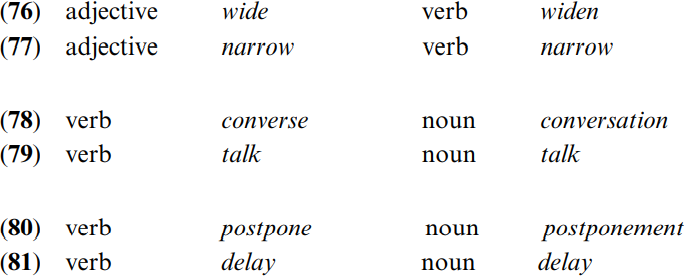


 Grammar
Grammar
 Tenses
Tenses
 Present
Present
 Past
Past
 Future
Future
 Parts Of Speech
Parts Of Speech
 Nouns
Nouns
 Verbs
Verbs
 Adverbs
Adverbs
 Adjectives
Adjectives
 Pronouns
Pronouns
 Pre Position
Pre Position
 Preposition by function
Preposition by function 
 Preposition by construction
Preposition by construction
 Conjunctions
Conjunctions
 Interjections
Interjections
 Grammar Rules
Grammar Rules
 Linguistics
Linguistics
 Semantics
Semantics
 Pragmatics
Pragmatics
 Reading Comprehension
Reading Comprehension|
Read More
Date: 2023-09-23
Date: 2023-11-24
Date: 2024-07-18
|
English has a number of derivational affixes that change word-class membership, but each applies to a limited set of words. Nouns formed from verbs include amusement, punishment; suggestion, conclusion; blessing, singing; resemblance; pleasure; Among adjectives derived from verbs are adorable, persuasive, contributory. Verbs derived from adjectives and nouns include purify, glorify; equalize, itemize; blacken, lighten, threaten. Most of these derivational endings are of French or Latin origin (notable exceptions being -en and -ing).
Quite a number of English words appear to belong to more than one word class, e.g.
adjective and verb: dirty, clean, tidy, narrow
noun and verb: stone, butter, bridge, cash
verb and noun: walk, punch, look, sleep, catch, laugh, roast
In each case, speakers have a clear intuition that one word-class membership is primary and the other secondary. Stone is said to be firstly a noun, although it can also be used as a verb (e.g. Stone the Christians!). Walk is regarded as a verb, which can also be used as a noun (That walk tired me out). In the tabulation just given, the primary word-class membership is given first (as, indeed, it generally is in dictionary entries).
There are two ways of dealing with the facts reported in the last paragraph. One is to say that stone, butter, etc. are nouns pure and simple, while walk, punch, etc. are verbs, and then to state that all nouns may be head of an NP, but a subset of nouns (stone, butter, etc.) may also function as head of a VP (taking appropriate verbal endings); and that all verbs can be head of a VP but that a specified subset of verbs (walk, punch, etc.) can also be NP head (and will then take appropriate nominal endings). The other approach is to say that the head of a VP can only be a verb, etc., and that English has derivational processes, with ZERO marking, that derive verbs from some nouns (verb stone from noun stone), and so on.
Evidence for preferring the second (zero derivation) alternative in the case of English comes from considerations of pairs like:

The words in each pair have related meanings. In each instance the first line shows an affix marking a derivational process. By analogy, it seems most satisfactory to say that the second line also involves a derivational process, with zero marking.
A further piece of evidence comes from examination of which words in a given semantic set may have double class membership. Consider:

It will be seen that, in each row, the most generic and commonly used noun also undergoes zero derivation to function as a verb, while those with more specific meanings lack this derivation.
In summary, English lacks a full array of productive derivational affixes; the suffixes (mostly of foreign origin) that are used each occur with a restricted set of roots. As a result there is much use of ‘zero derivation’, i.e. use of a noun in verb function without any change in form, etc.
Some generalizations are possible. Many verbs referring to CORPOREAL function can also be used as nouns, e.g. bite, swallow, drink, sniff, smell, taste, laugh, cry, sob, weep, wink, kiss, hug, pee. And many nouns referring to implements can also be used as verbs, e.g. spear, knife, saw, hammer, whip, nail, screw.
We will provide a full discussion of the eight types of nominalizations from verbs, and their markings—zero derivation, and also suffixes -er, -ant, -ard, -ing, -ation, -ment, -ance, etc. (Most suffixes mark several different kinds of nominalization, with different verbs.)
|
|
|
|
علامات بسيطة في جسدك قد تنذر بمرض "قاتل"
|
|
|
|
|
|
|
أول صور ثلاثية الأبعاد للغدة الزعترية البشرية
|
|
|
|
|
|
|
مكتبة أمّ البنين النسويّة تصدر العدد 212 من مجلّة رياض الزهراء (عليها السلام)
|
|
|